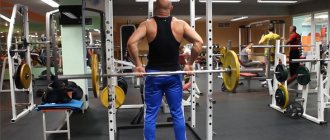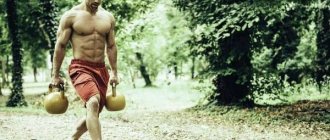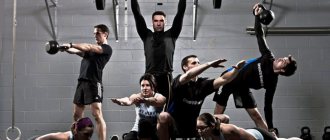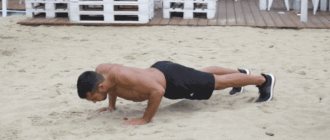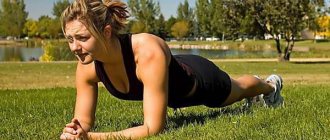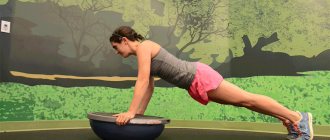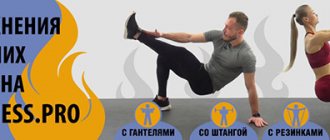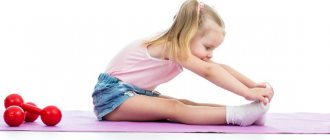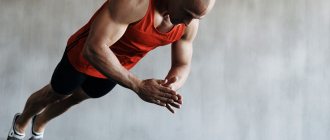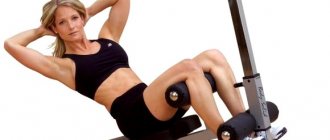Benefits of Dumbbell Curls
Pumped up, sculpted biceps not only look very beautiful (especially in combination with equally developed triceps). In addition, the biceps are a key working muscle in many exercises, such as various rows and pull-ups, so when you add this exercise to your training plan, you can expect progress in movements that require lifting heavy weights.
This exercise will also have a positive effect on grip strength, which helps in such complex exercises as pull-ups, deadlifts and bent-over barbell rows, where a strong grip is simply necessary.
And the last, but also important reason for systematically working on your biceps is that you will get well-deserved beautiful and powerful arms.
Working out the arm muscles: muscle work as the basis of health
An important condition for preserving joints is their nutrition. The blood supply to cartilage occurs thanks to the muscles, so strengthening them can prolong the youth of the musculoskeletal system.
It is important to remember that the hands must work, and not just perform a monotonous movement, which, on the contrary, is harmful to the joints. The key to prolonging the youth of the upper limbs, legs and body as a whole is stretching. This is a workout using dumbbells to train muscles.
How to do biceps curls correctly
There are many variations of this exercise, but the best place to start is with the standing dumbbell curl. Remember that the work here should be done by the biceps brachii - this is obvious and sounds cliche, but if you don't pay attention to your technique, other parts of the body will begin to join in and interfere with the exercise.
We get into the starting position, feet shoulder-width apart, knees slightly bent, holding a dumbbell in each hand. Your hands should be positioned at your hips and your palms should be facing away from you. Keep your elbows pressed tightly to your sides, your back as straight as possible, and your head and chest raised up. If you hold this position, you will be using your biceps and only your biceps to curl your arms.
We start the exercise by bending the elbows, slowly raising the dumbbells to the shoulders for three seconds. Lightly squeeze the biceps in the upper position of the movement to stimulate their growth. Then slowly and controlledly lower the dumbbells, slightly tensing the biceps in the lower position, thus achieving maximum range of motion.
You can perform lifts alternately or simultaneously with both hands.
But you can also train with your own body weight; try exercises without dumbbells at home to pump up all muscle groups.
A little about charging
After going on a diet, beauty does not return to the hands, since the muscles become weakened and atrophied. Only if a balance of physical activity and nutrition is maintained can the tone and harmonious shape of the whole body be restored.
Exercises for losing weight in your arms should be combined with squats, jumps, lunges, so that your metabolism is accelerated due to muscle work and aerobic activity. You can combine elbow curls, which work the biceps, with lunges, and dumbbell shoulder presses with squats. After all, the more muscles involved in the work, the easier it is to burn calories. And this is exactly what you need to lose weight.
How to choose the right weight
Many people who go to the gym want their biceps to look like they can move mountains. This is great, but you will only achieve this effect if you don't use too much weight. Lifting weights that are too heavy will result in poor technique that will not help your muscles develop.
Since dumbbell curls are an isolation exercise, it is very important to choose the right, ideal weight that will not force other muscles to work. For example, some people who are unable to reach the top position in this exercise often begin to lean back in order to get help from the push, the impulse. You can’t do this, because only the biceps should work here.
We choose a weight that will allow us to do three sets of 10-12 repetitions with good technique, so that the third set is difficult.
Exercises for children
The hand exercise complex for children is as follows:
- Connect the thumb to the middle finger, and place the index finger on top, as if holding a pen. Next, you need to show how the bird pecks the grains.
- Alternately, with one hand, touch the fingertips on the other. Within each touch they say: “Hello, my finger.” You can also call them by name.
- Next, it’s as if the fingers of different hands are shaking hands. During the exercise, the pads touch each other.
Variations of biceps curls
This exercise will bring you a lot of benefits, but once you have fully mastered it, you can begin to perform other variations and variations that will only expand the capabilities and improve the results of training your biceps for mass and relief.
Curling arms with dumbbells while sitting or lying down
If you find it difficult to keep your back straight, you can support it using a high incline bench.
Barbell Curl
The barbell curl is one of the most recognizable arm exercises in fitness and bodybuilding. This exercise will help build huge biceps, and compared to other variations, it allows you to lift heavier weights. The number of repetitions per approach is medium-high, usually from 8 to 12. Performed in conjunction with other arm exercises.
The positive side of using a barbell is that it allows you to add more weight to the exercise, but the negative is that it is too easy to add too much weight, which will definitely cause your form to suffer. If you notice that your back or other body part is starting to interfere with the exercise, simply reduce the load.
Advantages
- Makes biceps larger and stronger;
- Also increases forearm and grip strength;
- In the middle of the exercise, the biceps tense intensely;
- Possibility of heavier loads compared to other variations.
- Working muscle group: Biceps
- Type: Power
- Type (mechanics): Insulating
- Equipment: Barbell
- Difficulty level: Even a beginner can handle it
Improving motor skills
As part of the development of this function, attention should be paid to the implementation of one more complex. Exercises for fine motor skills:
- With the tip of the thumb on the right hand, alternately touch the index, ring, middle and little fingers, including those on the other hand.
- The same exercise is performed with the fingers on the left hand.
- With the pads of your right hand you need to touch the fingers of your left, but not in turn, but simultaneously.
- They touch with their fingers one by one: first, the thumb on the right touches the same on the left, then the index finger touches the index finger, and so on. Repeat several times.
- Straighten the index finger on the right hand and rotate it. This exercise is also called “wasp”. The same movements are made with the index finger on the left hand.
- Then the “wasp” exercise is performed with each element on both hands.
- The index finger and middle finger of the right hand run across the table. This exercise is called “little man”.
- The same movement is made with the fingers on the left hand.
Exercise therapy - Therapeutic gymnastics
A fracture is a complete or partial disruption of the integrity of a bone. Depending on how damaged the skin is, fractures are divided into closed and open. When a bone is fractured, the following phenomena are observed: pain, bruising and deformation, shortening of the limb, abnormal mobility, bone crepitus, and most importantly, dysfunction that occurs immediately after the injury. Among other things, any fracture is accompanied by injury to neighboring tissues, swelling, hematomas, and often muscles, ligaments, joint capsules, etc. are damaged. It should be noted that no one is immune from fractures and injuries of the upper extremities. And if such a situation arises, you should immediately contact a traumatologist. The doctor will apply a plaster cast. If the case is severe, then treatment can be very long, and surgery may even take place. The objectives of rehabilitation for fractures of the upper extremities are: preserving the life of the victim, the desire to achieve in the shortest possible time complete and strong fusion of bone fragments in their normal position, restoring the normal function of the injured limb and the working capacity of the victim. Treatment includes general and local procedures. To achieve proper fusion of bones during a fracture, fragments of the damaged bone should be placed in the desired position (the so-called fracture reposition) and held in this position until complete fusion (immobilization with a plaster cast, traction, or by osteosynthesis, in particular compression-distraction). If the fracture is open, then primary surgical treatment of the wound should be performed before immobilization. For normal fracture healing in the shortest possible time, it is necessary that the fixation of the reduced fragments be strong and reliable. In order to achieve immobility at the fracture site, it is necessary to provide this place with a plaster cast, as well as constant traction, osteosynthesis or compression-distraction devices. In order to restore the functions of the limb, as well as the patient’s ability to work, functional treatment methods are used, such as exercise therapy for fractures of the upper limbs, training on simulators, and exercises that promote tension and stretching of muscles. Therapeutic gymnastics for fractures of the upper limbs, massage, physiotherapy and hydrotherapy are also widely used. If physical therapy is used in the early stages of treatment, this will help eliminate symptoms such as pain, swelling, hemorrhage, etc. Among other things, physiotherapy accelerates the formation of callus, restores limb function, and also prevents postoperative complications. On the second or third day after the fracture, UHF or inductothermy, UV irradiation, laser therapy, electrophoresis with calcium and phosphorus, massage, as well as physical therapy for injuries of the upper extremities are prescribed. If muscle atrophy occurs, in such cases it is necessary to resort to electrical stimulation (with preliminary administration of ATP), vibration massage, stretching exercises, isometric exercises, training on machines, running and gymnastics in water, swimming, cycling, walking are also necessary skiing, various games. In the presence of joint contractures, doctors recommend electrophoresis with lidase, phonophoresis with lazonil, arthrosenex, mobilate, as well as LH for fractures of the upper extremities, which is carried out in water. Patients are recommended to exercise on exercise machines, cryomassage, sauna and swimming in the pool. In the presence of a plaster cast or compression osteosynthesis devices, such as the Ilizarov-Gudushauri, Dedova, Volkov-Oganesyan apparatus, etc. Moreover, from the first days of injury, exercise therapy for healthy limbs is included in the treatment process, which includes breathing exercises, general developmental and isometric exercises, stretching and so on. After the plaster cast and devices are removed, the patient is recommended to walk, and the use of axial load on the limb is also important. In case of fractures of the bones of the upper limb, PH is included in the rehabilitation process for injuries of the upper limbs, which helps to prevent contractures and stiffness of the finger joints, as well as preserve the ability to grip. After the plaster cast is removed, massage and occupational therapy of the injured limb are included; exercises that promote the acquisition of self-care skills are especially important. As mentioned above, in order to achieve a full recovery faster, you should not neglect exercise therapy. Therapeutic exercise and therapeutic exercises for fractures and injuries of the upper extremities are aimed at restoring the full range of motion in the joints and strengthening the muscles. Very often, exercise therapy for injuries of the upper extremities is prescribed to the patient immediately from the first days after receiving the injury. Moreover, light exercises are first used, the purpose of which is to reduce swelling and hematomas, as well as improve blood circulation. Later, exercises that help strengthen muscles are added to the complex of exercise therapy and physical therapy for fractures of the upper limbs. Then, exercises with resistance, weights and using various objects are gradually included. A set of exercises included in LG (therapeutic gymnastics) for fractures of the upper limbs (very important - when performing these exercises, make sure that there is no pain in the injured arm): Starting position - standing or sitting. 1. Perform circular movements with your shoulders, while swinging your affected arm. Raise your shoulders up. 2. Bend your arms at the elbows with tension, perform circular movements in the shoulder joint. 3. Raise your arms up to your sides, then lower them. Raise your arms forward and up, lower. 4. Place the sore hand on the healthy one, raise both hands up. 5. Perform a movement simulating chopping wood from the shoulder of the affected arm to the opposite knee. 6. Raise the sore hand up and stroke the hair. 7. Raise the affected arm up and touch it to the opposite shoulder. 8. Fold your hands into a “lock” and straighten your arms forward. 9. Bend your arms at the elbows. Then touch your shoulders with your hands, while bringing your elbows together. 10. Lower your arms along your body. Perform sliding movements with the hands up to the armpits along the side surface of the body. 11. With straight arms, clap your hands, first in front of you, and then behind you. 12. With straight, relaxed arms, perform circular movements. The following set of exercises for upper limb injuries is performed from a standing starting position, holding a gymnastic stick in your hands: 1. Raise your arms straight with the stick up. 2. Take the stick in one hand, extend the arm with the stick in front of you (the stick is in a vertical position). Transfer the stick from one hand to the other, while using your free hand to move to the side, up and in front of you. 3. Place the stick with one end on the floor, holding the other end with your sore hand, and move the stick like a lever. 4. Hold the stick in front of you with both hands extended forward and perform circular movements. 5. Put your hands down, holding a stick. Perform pendulum movements in one direction and the other. 6. Hold the stick in front of you with outstretched arms. The brushes should be brought together. Turn the stick in your hands like a “mill”, while moving your fingers. 7. Take a stick with your sore hand and move it back and forth (movements imitating a steam locomotive). Thus, we should not forget about the very positive role of exercise therapy for fractures of the upper limbs , and if you engage in physical therapy and gymnastics regularly, you can achieve excellent results and significantly bring the long-awaited recovery closer.
Exercise therapy for a fractured scapula.
Exercise therapy for fractures and dislocations of the shoulder.
Exercise therapy for a forearm fracture.
Exercise therapy for limb injuries.
Exercise therapy for spinal injuries.
- < Back
- Forward >
Charging for fingers
Among other things, there are the following finger exercises:
- First, clench the hand into a fist and rotate it ten times in each direction.
- Squeeze your hand tightly and hold it there for a few seconds, then relax. Repeat the exercise ten times.
- Pull the brush towards yourself as much as possible, and then do the same from yourself. Perform this exercise five times with each hand.
- They clench their fist. Then they open and retract their fingers one by one.
- Place the brushes on a hard surface. Then each finger is lifted in turn, but the others cannot be pulled off.
These light exercises can serve as an excellent prevention of joint pathologies, and in addition, they relieve fatigue from the hands at the end of the working day.
